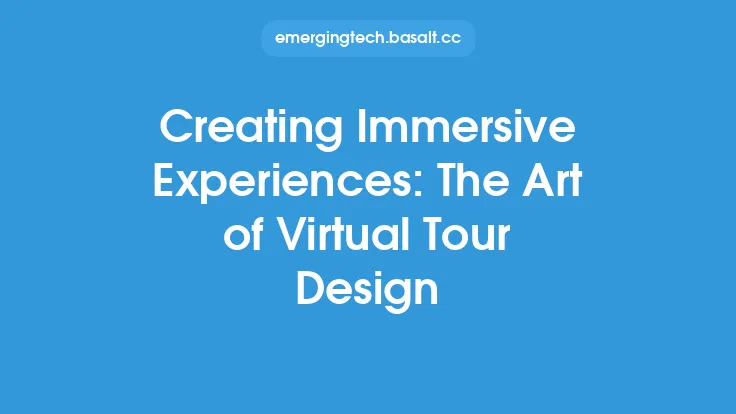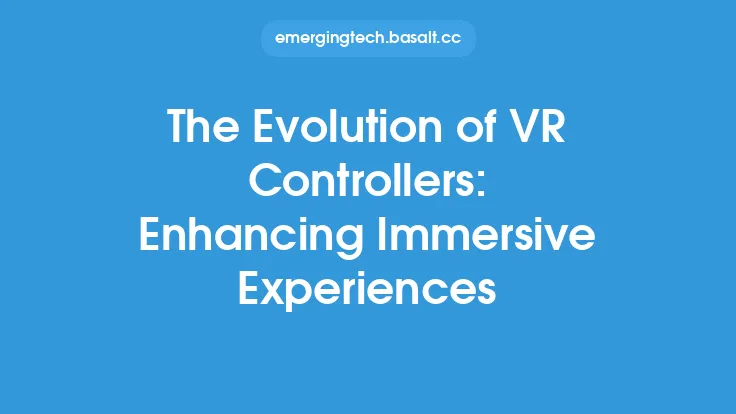The concept of virtual reality (VR) has been around for decades, but it's only in recent years that the technology has advanced to the point where it can provide a truly immersive experience. One of the key components of this experience is audio, and virtual reality audio solutions have become a crucial aspect of VR technology. In this article, we'll delve into the world of VR audio, exploring the different types of audio solutions, the technologies behind them, and how they enhance the overall VR experience.
Introduction to Virtual Reality Audio
Virtual reality audio refers to the use of audio technologies to create a immersive and interactive audio environment that simulates the way we hear sound in the real world. This involves the use of various audio techniques, such as 3D audio, spatial audio, and binaural recording, to create a sense of presence and immersion. The goal of VR audio is to transport the listener into a virtual world, where they can interact with virtual objects and environments in a realistic and engaging way.
Types of Virtual Reality Audio Solutions
There are several types of VR audio solutions, each with its own strengths and weaknesses. Some of the most common types of VR audio solutions include:
- Binaural Recording: This involves recording audio using a pair of microphones, one for each ear, to create a 3D audio effect. Binaural recording is often used in VR applications to create a sense of presence and immersion.
- Spatial Audio: This involves the use of audio processing techniques to create a sense of space and distance in the audio environment. Spatial audio can be used to create a sense of depth and distance in the virtual world, making it feel more realistic and immersive.
- 3D Audio: This involves the use of audio processing techniques to create a sense of height and width in the audio environment. 3D audio can be used to create a sense of presence and immersion, and is often used in combination with spatial audio and binaural recording.
- Object-Based Audio: This involves the use of audio objects, such as 3D models of sound sources, to create a sense of space and distance in the audio environment. Object-based audio can be used to create a sense of realism and immersion, and is often used in VR applications.
Technologies Behind Virtual Reality Audio Solutions
The technologies behind VR audio solutions are complex and involve a range of audio processing techniques. Some of the key technologies used in VR audio include:
- Head-Related Transfer Functions (HRTFs): These are used to simulate the way sound interacts with the human head and ears. HRTFs are used to create a sense of presence and immersion, and are often used in combination with binaural recording and spatial audio.
- Audio Rendering: This involves the use of audio processing techniques to create a sense of space and distance in the audio environment. Audio rendering is used to create a sense of realism and immersion, and is often used in combination with object-based audio and 3D audio.
- Acoustic Simulation: This involves the use of audio processing techniques to simulate the way sound interacts with the environment. Acoustic simulation is used to create a sense of realism and immersion, and is often used in combination with spatial audio and object-based audio.
Enhancing the Immersive Experience
VR audio solutions can enhance the immersive experience in a range of ways. Some of the key ways in which VR audio can enhance the immersive experience include:
- Creating a Sense of Presence: VR audio can create a sense of presence and immersion, making the user feel like they are really in the virtual world.
- Simulating Real-World Environments: VR audio can simulate real-world environments, such as the sound of a city or the sound of a forest, to create a sense of realism and immersion.
- Enhancing Interactivity: VR audio can enhance interactivity, allowing users to interact with virtual objects and environments in a realistic and engaging way.
- Creating a Sense of Space and Distance: VR audio can create a sense of space and distance, making the virtual world feel more realistic and immersive.
Applications of Virtual Reality Audio Solutions
VR audio solutions have a range of applications, including:
- Gaming: VR audio can enhance the gaming experience, creating a sense of presence and immersion, and simulating real-world environments.
- Education: VR audio can be used in educational applications, such as virtual field trips, to create a sense of presence and immersion, and to enhance interactivity.
- Entertainment: VR audio can be used in entertainment applications, such as virtual concerts, to create a sense of presence and immersion, and to enhance interactivity.
- Therapy: VR audio can be used in therapy applications, such as exposure therapy, to create a sense of presence and immersion, and to enhance interactivity.
Conclusion
Virtual reality audio solutions are a crucial aspect of VR technology, and can enhance the immersive experience in a range of ways. From binaural recording to object-based audio, the technologies behind VR audio are complex and involve a range of audio processing techniques. As VR technology continues to evolve, we can expect to see even more advanced VR audio solutions, with applications in gaming, education, entertainment, and therapy. Whether you're a developer, a user, or simply someone interested in the latest VR technology, virtual reality audio solutions are definitely worth exploring.





